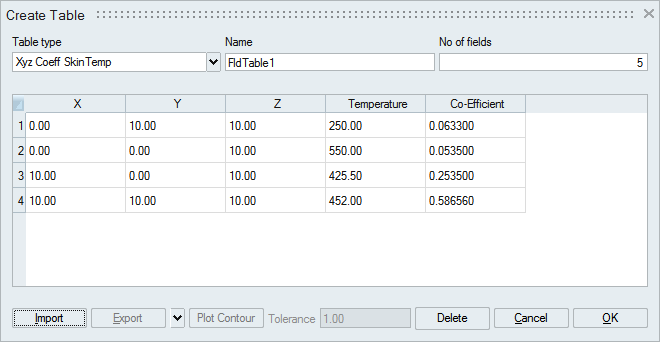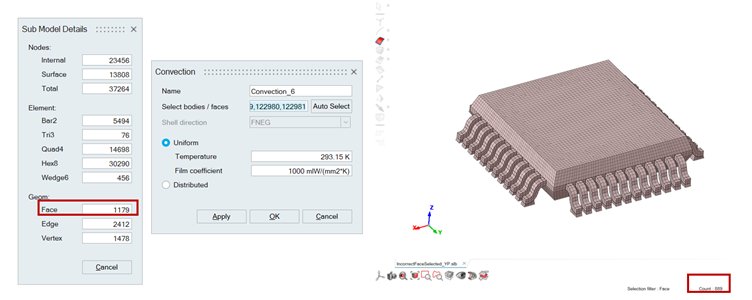Convection
![]()
This tool is used to define heat transfer from surfaces due to convection. The film condition (sink temperature and film coefficient) which defines surface heating or cooling due to convection by surrounding fluids can be defined.

The total convection heat can be checked using the Solution browser | Heat source (Right click) option.
Description
- Distributed convection table option is used to apply a spatially varying
convection load. An external file containing the spatial data of the format
X, Y, Z, Temperature, FilmCo-efficient can be imported.

- The varying convection table data can be applied using the following
interpolation methods
- Closest Point
For each node of the selected Face/Body, the nearest XYZ data from the given table is obtained and the corresponding Film Co-efficient and Temperature values are assigned to the node.
- Weighted Distance
For each node of the selected Face/Body, a bunch of XYZ data (close to the node) is obtained from the given table and then the Film Co-efficient and Temperature values for the node is obtained based on the distance from the node to the XYZ data. The XYZ data nearest to the node has a greater influence on the Film Co-efficient and temperature values for the node.
- Closest Point
- The varying convection table data can be mapped in the following methods
- Element Centroid
While writing Abaqus Input file, for each element of the selected Face/Body, the Film Co-efficient and Temperature values nearest to the element centroid position is found out and then assigned to it.
- Element Nodal
While writing Abaqus Input file, for each element of the selected Face/Body, the Film Co-efficient and Temperature values nearest to corner nodes of the element are obtained and then assigned to the element by averaging the corner node values.
- Element Centroid
- Time-dependent ambient temperature can be defined by using the Amplitude table to vary the ambient temperature based on time.
- Time-dependent HTC can be defined by using the Amplitude table to vary the heat transient co-efficient based on time.
- Convection faces are automatically extracted from the Current Solution bodies.
- The overlapping elements, shared faces are skipped when convection faces are extracted using Auto-Select.
- Supported only for FEM bodies.
Below example: Using Auto-Select algorithm 889 faces are extracted for external convection.

Cards supported for various solvers
| Solver | Supported Cards |
|---|---|
| Nastran | TEMP, CONV, PCONV |
| OptiStruct |
CONVG, CNVGADD |
| Abaqus | *SFILM, *FILM |
| Permas | CONA, DISLOAD TEMPFILM |
| Ansys | SFE |